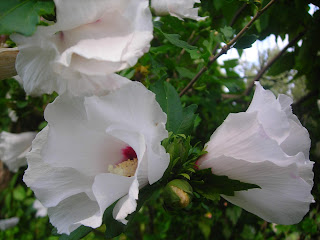Rose of Sharon - Hibiscus
syriacus
By Kim Willis These articles are copyrighted and may not be
copied or used without the permission of the author.
 |
| Rose of Sharon |
If you
need color in the landscape in late summer and early fall Rose of Sharon may be
the plant you are seeking. Sometimes
called Althea or Rose Mallow these plants have been in gardens for centuries. Your grandmother may have had one in her yard
but even if you consider yourself a cutting-edge gardener there is a Rose of
Sharon perfect for your garden.
Because
Rose of Sharon is in the Hibiscus family and the flowers are typical of that
family there is some confusion when using common names for the plant. It should
not be called hardy hibiscus. The Rose of Sharon or althea is a deciduous woody
plant, forming a bush or small tree.
Hardy hibiscus are herbaceous plants, they die back to the ground each
year. Tropical hibiscus of various
species are also bushes or trees but they are not hardy in the United States
except in zones 8 and higher and are generally kept as potted plants.
Rose of
Sharon, Hibiscus syriacus, is native
to India and Asia but not to Syria. It
has been planted around the world in temperate regions and sometimes
naturalizes. The natural shape of the
shrub is vase like with many long straight stems rising to a height of about 12
feet. Nurseries and gardeners often
prune and train them into a more tree like shape, with a central trunk.
Rose of
Sharon makes an excellent tall screen or hedge when planted closely. They are also planted as landscape accents or
garden focal points. They are easily
pruned to keep them within the boundaries of your garden.
The
bark on trunks and stems of Rose of Sharon is pale gray and smooth. The leaves are about 3 inches long with 3
distinct lobes and a coarse toothed margin. They are arranged alternately on
the stems. Leaves are green, sometimes
tinged with purple or maroon. The
flowers are the fall show- the Rose of Sharon leaves fade to dull yellow brown
in the fall.
The
flowers of Rose of Sharon are produced profusely from late July to hard frost,
depending on the variety and planting zone.
In the single flowered varieties there are 5 petals forming a circular
flower up to 4 inches across. There is a
prominent protruding pistil in the center typical of hibiscus flowers. However, many cultivated varieties are now
double flowered, looking more like the rose they are named for or like small
peonies.
The
flowers of Rose of Sharon come in a wide range of colors from white, through
shades of blue, mauve, pink and purple.
There are bi-color varieties.
There are no true red or yellow flowered varieties. Flowers remain open at night. They are attractive to hummingbirds, moths
and butterflies.
Flowers
turn into brown, 5 chambered seed capsules. Older varieties re-seed freely and
some gardeners consider them invasive. Newer varieties, including many double
flowered Rose of Sharon are sterile and don’t make seeds.
Growing Rose of Sharon
Rose of
Sharon can be grown from seed quite easily, although it may take 2 or more
years for them to flower. Some varieties
are not available from seeds as they are sterile and are reproduced through
cuttings. I recommend gardeners start
with plants, which are sold bare root or potted. You will then know what color and type of
flowers to expect.
Rose of
Sharon blooms on new wood, so prune them for shaping only in winter or early
spring while still dormant if you want blooms.
Some gardeners prune each branch back to 3 buds to make the flowers
larger. If your plant is trained to a
tree shape you may want to trim back any branches that grow too long
horizontally and remove branches appearing at the trunk base.
A light
application of slow release fertilizer in spring as plants begin new growth is
helpful for good growth and flowering.
Keep plants well-watered as they get established, after that they are
pretty drought tolerant. Flowers will be
larger in dry years if they are given supplemental watering.
Japanese
beetles are fond of Rose of Sharon and can severely damage foliage in some
years. Whiteflies and aphids are
sometimes problems also and plants should be treated with pesticides if pest
numbers get high. Rose of Sharon are
occasionally hit with fungal diseases such as rust or leaf spot diseases, but
they rarely kill the plant.
If you
have a small garden you may want to try a new Rose of Sharon sold by Proven
Winners called Purple Pillar®. While
this plant gets tall- up to 16 feet- it’s very narrow and columnar, only about
2-3 feet wide. It is covered with lilac
purple flowers in late summer.
Edible and herbal uses
Rose of
Sharon flowers and leaves are edible.
Leaves are cooked as a green when young or added to salad. Flowers are added to salads and both flowers
and leaves are made into tea.
In
Korean and Asian medicine there are many uses for Rose of Sharon.
Leaves
are diuretic,
expectorant and used for stomach problems. A decoction of the flowers is diuretic,
used as an eye wash, and as a treatment for itching and other skin
diseases.
Decoctions
of Rose of Sharon root bark are mucilaginous and are used for diarrhea, stomach
cramps, menstrual problems, as a vermifuge, and externally to treat skin
disorders.
I can
find no serious toxicity or side effects listed for Rose of Sharon but as with
most herbal medicines use carefully until you see how it affects you.

No comments:
Post a Comment